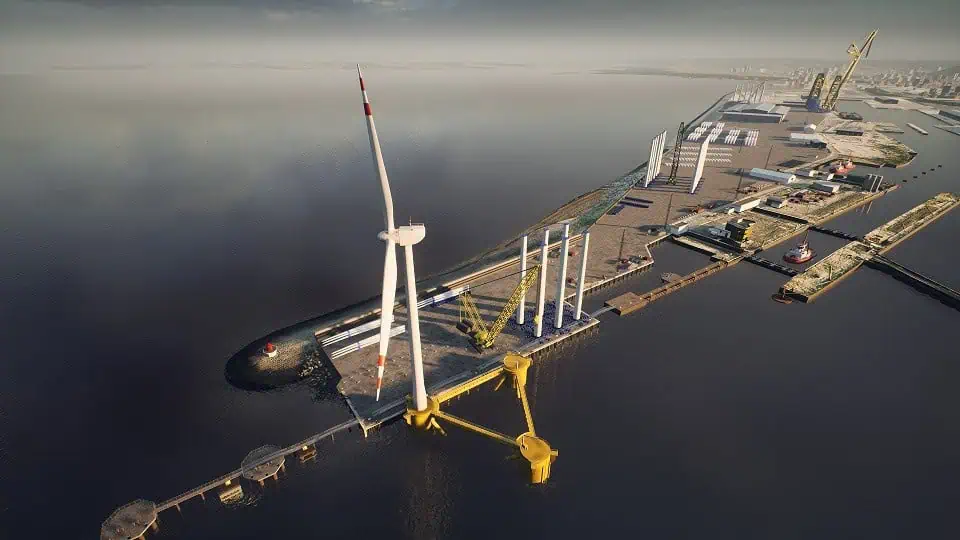Forth Ports today (25th May, 2021) unveils ambitious proposals for the creation of Scotland’s largest and best located renewable energy hub on a 175 acre site at the Port of Leith – supporting Scotland’s economic recovery and energy transition plans and the achievement of Scotland’s net zero carbon emissions targets.
This £40m private investment will see the creation of a bespoke, riverside marine berth capable of accommodating the world’s largest offshore wind installation vessels. The facility will feature a heavy lift capability of up to 100 tonnes per square metre (t/m2), backed up by 35 acres of adjacent land for logistics and marshalling. This will be supplemented by the upgrading of a 140 acre cargo handling site to accommodate lay down; assembly; supply chain and manufacturing opportunities. The total area is equivalent to around 100 full size football pitches. [See downloadable CGI video here: https://vimeo.com/554214247/cf526c091e]
The Port of Leith Renewable Energy Hub has the potential to:
- Make a major contribution to Scotland achieving its 2045 net zero greenhouse gases target
- Secure the Firth of Forth as the driver for Scotland’s green energy transition
- Help spearhead Edinburgh’s and Scotland’s Covid-19 recovery plan
- Support up to 1,000 high quality, long term direct jobs and about 2,000 indirect jobs
Launching the plans, Charles Hammond OBE, Group Chief Executive of Forth Ports, said: “We are committed to playing a significant role in the renewable energy sector and, through that, Scotland’s energy transition to net zero as we also tackle the challenges of Covid-19 recovery and economic regeneration. This is a pump-priming investment in logistics and marine infrastructure at the Port of Leith as we harness Scotland’s natural resources for future generations and has the potential to play a significant part in our forthcoming Firth of Forth Green Port bid.
“Leith’s proximity to the North Sea, which is set to become home to many more offshore wind developments, coupled with the natural deep waters of the Firth of Forth, makes this an ideal location to support not only those developments already planned, but the pipeline of projects that are sure to follow. That’s why we’re prepared to invest our land, our expertise and our shareholders’ money to further build and strengthen Scotland’s renewables supply chain to deliver new long-term jobs. Forth Ports is committed to both help make Scotland’s renewables future a reality and help it meet its carbon reduction targets.”
Cabinet Secretary for Net Zero, Energy and Transport, Michael Matheson, said:
“The Scottish Government has set ambitious targets to increase offshore wind capacity to 11 GW of energy installed by 2030 – enough to power more than eight million homes. This commitment, which will support our transition to a net-zero economy by 2045, capitalises on the fact that Scotland’s seas have some of the best offshore wind resources in the world.
“It is fundamentally important that the bold and necessary action required for us to reach net-zero is taken in a way that is fair and just for everyone. It must seize the economic benefits that will be created, supporting jobs and our wider society.
“This significant investment from Forth Ports to develop the Port of Leith places them in an ideal position to harness the offshore wind opportunities in the North Sea, creating good green jobs and supporting a just transition to net-zero – not just for the city of Edinburgh but the wider area and beyond.”
City of Edinburgh Council leader, Councillor Adam McVey, said:
“Renewable energy plays a vital role in tackling climate change and in securing a bright economic future for everyone in our Capital. The increase in jobs for people in Leith and across Edinburgh is hugely welcome and underlines our economic resilience as a City. The continuing regeneration of clean industry in the docks with the development of the Port of Leith Renewable Energy Hub is an important and welcome step in supporting the needed transition to a cleaner, greener future for the next generation.”
Claire Mack, Chief Executive of Scottish Renewables, said:
“Scotland is at the start of its offshore wind journey, with plans to increase capacity tenfold in the coming decade. Ports and harbour infrastructure have an enormous role to play in the growth of that multi-billion pound sector which, with support from government and industry, is likely to grow much more quickly than it has to date.
“The announcement of such significant activity by Forth Ports is hugely welcome and will act as a signal to draw other, wider private and public sector investment to grow the skills, expertise, innovation and supply chain we need to make the most of this exciting next phase of the renewable energy industry’s development. The Scottish Government’s Sectoral Marine Plan contains many sites for floating wind development which, coupled with investments in infrastructure capable of handling the scale of floating turbine technology, mean we have a chance to gain a foothold in a market with enormous economic and export opportunities, particularly in the US and Asia. Scotland can truly lead the world in offshore wind, and today’s news from Leith is the first step in that journey.”
This will be a wholly private sector investment of £40m, backed by Forth Ports’ shareholders, in support of the industrial regeneration of the Port of Leith and reinforcing the role of the Firth of Forth in Scotland’s energy transition. It will further underpin the position of Scotland’s Central Belt as a leading area of engineering and manufacturing skills and capabilities.
With existing offshore wind farm development plans and the Crown Estate Scotland’s ScotWind seabed leasing round still to come, offshore wind alone has the potential to create enough work for this renewables hub for the next 30 years. The Firth of Forth’s natural deep waters and its proximity to the North Sea make it ideally suited to supporting future offshore wind farm development, both fixed and floating.













